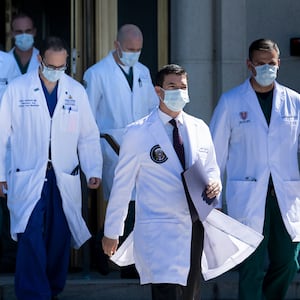With President Trump in Walter Reed Army Hospital, the public was inevitably going to worry, wonder, and speculate about his current and longer-term health. But his doctors are making a bad situation much worse with a cascade of confusing statements, half-truths, and rosy assessments at a time when transparency is vital.
At best, his team is inviting confusion and fear after getting caught up in a White House trying to reassure the public but doing the opposite. At worst, they are misleading the public about the president’s infection with a virus, one the president has long downplayed himself.
At a televised press conference on Saturday, Dr. Sean Conley, the president’s physician, gave an upbeat account of Trump’s health and prognosis. But he dodged questions about or simply failed to say whether he had been given supplemental oxygen, how high his temperature reached, or what ultrasounds had been taken. Instead, Dr. Conley told the press that Mr. Trump’s hospitalization was “purely precautionary.” He went on to offer another update Saturday night noting that the president continues to “do well” after making “substantial progress,” even though he conceded that Trump is “not yet out of the woods.”
The president himself has conveyed only encouraging news, saying he feels as if he could leave the hospital now, according to Dr. Sean Dooley, a pulmonologist treating him. He echoed that outlook in a four-minute video posted on Twitter late Saturday, in which he said he believed he would “be back soon” and was “starting to feel good” but conceded that the “real test” would be over the next few days.
This optimistic picture stands in stark contrast with new information that has emerged since Friday. The New York Times and Associated Press are now both reporting that Mr. Trump received supplemental oxygen at the White House on Friday. The president’s own chief of staff, Mark Meadows, told Fox News on Saturday that while the president has improved, he “had a fever, and his blood oxygen level had dropped rapidly” on Friday, leaving staffers “real concerned.”
This is a worrying development, which explains his transfer to Walter Reed, and the decision to treat the president with a five-day regimen of remdesivir, an anti-viral treatment with limited effectiveness. The Food and Drug Administration granted emergency use authorization (EUA) for the drug to treat COVID-19 patients who are severely ill or hospitalized.
There are additional causes for concern. Even taking the White House at its word, the timeline for the president being tested, diagnosed, and treated has been deeply alarming. At the press conference Saturday, the president’s doctors implied Mr. Trump has been symptomatic for 72 hours—or at least diagnosed that long ago. If that were true, the president is not out of harm’s way yet: It is often 7-10 days after contracting the coronavirus before patients deteriorate, though earlier deterioration certainly can occur.
But there’s reason to question whether Dr. Conley’s account—which he has since sought to correct to indicate he simply meant this is the third day of the president facing a COVID-19 case—was not transparent, much less chronologically accurate. Just after Dr. Conley spoke, White House Chief of Staff Mark Meadows offered an off-the-record statement that contradicted Mr. Trump’s physician: “The president’s vitals over the last 24 hours were very concerning and the next 48 hours will be critical.”
If Dr. Conley’s statement was accurate, and the president was diagnosed with COVID-19 72 hours ago, that would have been on Wednesday, well before the public was notified early Friday morning. Dr. Conley did also say there was “repeated testing” on Thursday afternoon due to exposure to a close contact. So, it could be the president tested positive with a rapid antigen test, followed by a more accurate PCR test. But wouldn’t the president self-isolate right after the first rapid test until it was confirmed whether or not he was infected?
The president has also been given another investigational treatment developed by Regeneron Pharmaceuticals, an antibody cocktail REGN-COV2. This antibody treatment is intended for non-hospitalized COVID-19 patients, with preliminary data showing it reduces viral load and the time needed to alleviate symptoms.
Dr. Brian Garabaldi, another Trump physician, suggested the president received the treatment 48 hours ago—that is Thursday morning, a day before the White House informed the public that he had been given REGN-COV2. That timeline, too, was subsequently walked-back—though not by Garabaldi himself—in an attempt to suggest what was meant was in fact that this is the second day since the president received the treatment.
Each scenario here is a frightening one. If the president’s COVID-19 diagnosis was initially made on Wednesday, it would mean that the president was permitted to travel to campaign events knowing he had SARS-CoV-2 infection and was presumably infectious to others. This would have major public health consequences. Since the Rose Garden nomination of Amy Coney Barrett to the Supreme Court on Sept. 26, at least 8 attendees have tested positive for COVID-19. And Cleveland Health officials traced at least 11 COVID-19 cases arising from the presidential debate on Sept. 29.
Many attendees at the Rose Garden and in Cleveland were not wearing masks.
The president has also been in close contact (without social distancing) with prominent GOP members of Congress. Sens. Mike Lee (R-UT), Thom Tillis (R-NC) and Ron Johnson (R-WI) have announced positive test results, which may be the tip of the iceberg of a COVID-19 cluster in Congress. In short, the organs of the U.S. government (the White House and Congress) may have been exposed to a serious disease against the advice of its own scientists and public health agencies.
It seems inconceivable that in the midst of a pandemic and with more than 200,000 American deaths, the White House would permit the president to travel and mingle with the public. If the president knowingly did expose others to a significant risk, it would be a blatant disregard of strict CDC guidelines to self-isolate after a confirmed diagnosis. I can only conclude that the timeline given to the public must have been inaccurate, and that the subsequent statements of clarification are genuine ones.
But even this scenario leaves plenty of uncertainty about the president’s health.
The public has the right to accurate, timely information on a grave threat to the health of the president of the United States. Beyond clarifying the timeline, from a clinical perspective we must understand accurately and in real time three important facts: the president’s temperature, his oxygen level, and the results of ultrasounds. White House physicians have a public responsibility to be clear and honest about these and other relevant medical facts. Transparency is at the heart of American democracy. You might recall that the president told Bob Woodward he would underplay the COVID-19 pandemic to avoid causing public “panic.”
This much is clear: If the White House wishes to calm the American public and gain our trust, the only way to do that is with timely, complete, and accurate information. Absent honest and transparent communication, social media will fill in the gaps, and misinformation will spread as fast as the coronavirus.




